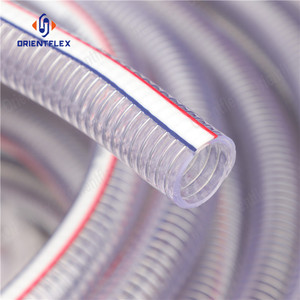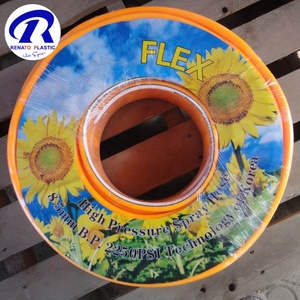(27787 products available)










































































































































































































A braided hose pipe is a pipe with an inner tube, a mesh braid, and an outer cover. They are used in various applications to transport fluids. They come in different types and sizes depending on the application. Below are the types of braided hose pipes.
Water Hose
A water hose pipe is a braided hose pipe used for watering plants in gardens and farms. It is also used to water flowers and other plants. The hose pipe is popular due to its lightweight and flexible nature. A small garden can use a 1/2-inch hose, while a larger garden will require a 5/8-inch hose. Water hoses are made from different materials, and their durability depends on the material used. PVC water hoses are lightweight and very flexible, but they are not as durable as the other options. They are best suited for light-duty tasks. Rubber water hoses are flexible, durable, and can withstand extreme temperatures. They require less space when coiled. They are popular and used in most gardens. Vinyl braided hoses are made from a combination of vinyl and reinforced nylon. They are very lightweight and flexible but less durable than other options. The hose diameter, length, and material affect the water flow rate. A larger diameter hose will have a higher flow rate than a smaller one. Similarly, a shorter hose will have a higher flow rate than a longer one.
Steam Hoses
Steam hoses are specifically designed for transporting steam. They have a thick inner lining to prevent leaks and bursts. Steam hoses are generally reinforced with nylon braiding for strength and durability. These steam braided hoses have a rubber outer cover that protects them from abrasion and extreme temperatures. They can operate at a temperature of up to 350 degrees Fahrenheit. Steam hoses are made of different materials, including neoprene, rubber, and silicone. They are used in industrial settings, such as food processing, cleaning, and manufacturing. The hoses are colored black to distinguish them from other types of braided hoses.
Oil Hoses
Oil hoses are designed for transporting oil and petroleum products. They have a synthetic rubber inner lining that prevents oil from leaking. Oil braided hoses are reinforced with nylon braiding for strength and durability. They are usually black and have a smooth outer cover. Oil hoses are more durable than steam and water hoses. They can withstand high pressure and are resistant to kinks and cuts. The hoses are made from different materials, including neoprene, rubber, and silicone. They are used in industrial settings, such as food processing, cleaning, and manufacturing.
Braided hoses are used in various applications, and their features may differ based on their application. However, they commonly have features that include:
Flexibility
Braided hoses are flexible. They can bend and twist easily without kinking or collapsing. Their flexibility allows them to be installed in tight spaces or around obstacles. Flexibility enhances the braided hose pipe's ability to withstand vibrations and movements.
Lightweight and compact
Braided hoses are lightweight. They reduce the overall weight of the system, which is important in applications like automotive. Their design makes them compact. This allows for easy routing and installation in confined spaces.
Enhanced Pressure and Temperature Resistance
Braided hoses have reinforced walls. This allows them to withstand high pressures without bursting or leaking. Different materials have different temperature resistance capabilities. For example, nylon sheathing is used for high-temperature applications.
Durability and Strength
These hoses are long-lasting. They withstand wear, abrasion, and extreme weather without tearing or ripping. Braided hoses maintain their performance over time with minimal degradation. They are designed to endure repeated bending and flexing. This prevents them from collapsing or kinking.
Corrosion and Abrasion Resistance
The materials used to make braided hoses are resistant to corrosion. These include: Nylon, stainless steel, and aluminum. The braided design offers abrasion resistance. This prevents the hose from being damaged when it comes into contact with sharp objects or rough surfaces.
Versatility
Braided hoses are used in various applications. They are designed to work with different fluids and gases. These include: Water, air, hydraulic fluids, and fuel. Braided hoses have different diameters and lengths. This makes them suitable for different systems and applications.
Pressure Rating
Every braided hose has a pressure rating. It indicates the maximum pressure the hose can withstand safely. They are suitable for applications with high-pressure requirements.
Low Permeability
Braided hoses have low permeability. This prevents fluids or gases from leaking or seeping through the hose material. Low permeability is important in applications requiring tight containment.
Braided hose pipes are popular because of their flexibility, strength, and resistance to kinks. They can also withstand pressure and are lightweight. The applications of a braided hose pipe include:
Pressure and temperature ratings:
Each application involves a specific pressure and temperature range. Check the pressure rating of the braided hose pipe. It shows how much pressure the pipe can handle safely without bursting. Higher pressure ratings are needed for applications with high pressure.
Also, consider the temperature of the fluid. Some hoses work well with hot fluid, while others handle cold fluid better. Pick one with a temperature rating that matches the fluid temperature.
Compatibility with fluids:
The braided hose pipe carries different fluids, like water, oil, or chemicals. Check if the hose material is compatible with those fluids. This stops the hose from breaking down or leaking.
Construction and materials:
The operating environment influences the braided hose materials. If it's very hot, materials that resist heat well are needed. Extreme heat could melt other materials. Think about the conditions, like pressure and temperature, to pick the right braided hose.
Size and length:
The hose diameter affects flow speed. A wider diameter means a faster flow. The hose also comes in different lengths. A longer hose gives more flexibility to connect distant parts. But, longer hoses may reduce the fluid pressure a bit.
Quality and standards:
Quality is very important when choosing braided hoses. Good quality hoses last longer and perform better. Check for industry standards and certifications, like ISO or SAE. Hoses meeting these standards show they were made properly.
It's also best to pick hoses from known manufacturers. Their products have proven reliability, so they can be trusted.
Q1: What does the braided hose pipe do?
A1: A braided hose pipe is used to convey fluids and gases in industries, automotive applications, and plumbing systems.
Q2: How long do braided pipes last?
A2: Braided pipes can last between 5 to 10 years or more. However, their lifespan depends on factors like proper installation, usage, and maintenance.
Q3: How is a braided hose cleaned?
A3: To clean a braided hose, detach it from the connection. Then, use a soft brush and mild detergent to clean the exterior. Rinse the braided hose with clean water and let it dry completely.
Q4: Does a braided hose decrease pressure?
A4: No, a braided hose does not decrease pressure. In fact, it can maintain or withstand higher pressures compared to non-braided hoses. A braided hose is ideal for applications that require high-pressure fluid transfer.